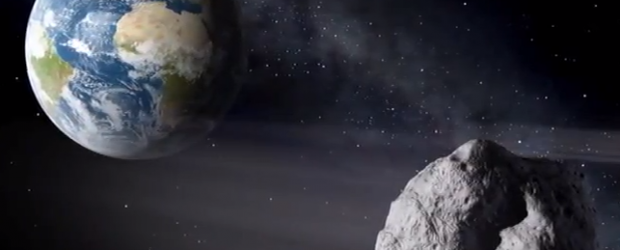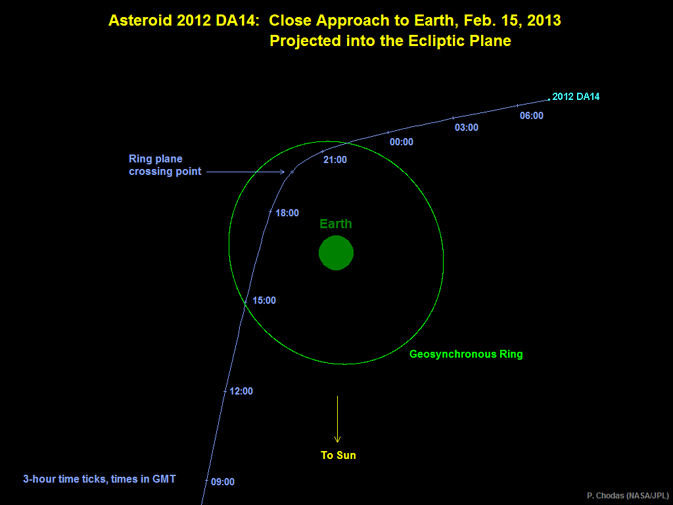Source: The Watchers - 2/14/13, By Adonai

Asteroid 2012 DA14 was discovered by the La Sagra Sky Survey, Spain on February 23, 2012 and it was about 2.7 million miles (4.3 million kilometers) distant at the time of first observation. It’s flyby is the closest ever predicted Earth approach for an object this large (first estimates 45 m) which makes it such an interesting NEO. It is traveling at about 17,450 miles per hour (28,100 kilometers per hour), or 4.8 miles per second (7.82 kilometers per second) relative to Earth and by latest estimates it is about 65 meters in diameter.
It will be closest to Earth on February 15, 2013 at approximately 19:24 UTC (2:24 p.m. EST/11:24 a.m. PST). At the time of closest approach, the asteroid will be over the eastern Indian Ocean, off Sumatra — approx. latitude: -6 deg South. / longitude: 97.5 deg East. Depending on local weather, it will be visible from parts of Europe, Africa and Asia. 2012 DA 14 will appear to be moving relatively quickly as it crosses the sky from the south to the north, it will be too faint to be visible to the naked eye, but it can be picked up with a good pair of binoculars.
Graphic depicts the trajectory of asteroid 2012 DA14 on Feb 15, 2013. In this view, we are looking down from above Earth’s north pole. Image credit: NASA/JPL-Caltech
At the time of closest approach asteroid 2012 DA 14 will be only about 17,200 miles (27,700 kilometers) above Earth’s surface. This distance is well outside Earth’s atmosphere, but it is inside the belt of satellites in geostationary orbit, which is located 22,200 miles (35,800 kilometers) above Earth’s surface. The close-approach distance is only about one-tenth the distance between Earth and moon or about twice the diameter of the Earth.
Where to watch asteroid 2012 DA14 live
- NASA Television will provide commentary starting at 2 p.m. EST Feb 15 (11 a.m. PST, 19:00 UTC). The commentary will be available via NASA TV and streamed live online at: http://www.nasa.gov/ntv and http://www.ustream.tv/nasajpl2
- In addition to the commentary, near real-time imagery of the asteroid’s flyby before and after closest approach, made available to NASA by astronomers in Australia and Europe, weather permitting, will be streamed beginning at about noon EST (9 a.m. PST, 17:00 UTC) and continuing through the afternoon at the following website: http://www.ustream.tv/nasajpl2
- Slooh Space Camera will cover its near-approach on Friday, February 15th, with several live shows on Slooh.com, free to the public, starting at 6 PM PST / 9 PM EST / 02:00 UTC (2/16) – International times here: http://goo.gl/ythGd - accompanied by real-time discussions with Slooh Space Camera’s Paul Cox, astronomer and author Bob Berman, and Prescott Observatory manager, Matt Francis. Viewers can watch live on their PC or IOS/Android mobile device. https://plus.google.com/u/0/108176209664415419112/posts/TqoA426EhKB
- A Ustream feed of the flyby from a telescope at NASA’s Marshall Space Flight Center in Huntsville, Ala., will be streamed for three hours starting at 9 p.m. EST (8 p.m. CST, 02:00 UTC). To view the feed and ask researchers questions about the flyby via Twitter, visit: http://www.ustream.tv/channel/nasa-msfc
- Remotely controlled Robotic Telescopes announced their coverage here: http://www.virtualtelescope.eu/webtv/
- Note: Have more links for live coverage of 2012 DA14 flyby? Contact us or post in comments, tnx.
Need help converting times to your local time? – Use this tool.
What would happen if 2012 DA 14 would impact the Earth
It is believed that there are approximately 500,000 near-Earth asteroids the size of 2012 DA14. Of those, less than one percent have been discovered. Scientists at NASA’s Near-Earth Object Program Office in Pasadena, Calif. estimate that an asteroid the size of 2012 DA14 flies this close every 40 years on average and that one will impact Earth, on average, about once in every 1,200 years.
Asteroid 2012 DA14 will not impact Earth, but if another asteroid of a size similar to that of 2012 DA14 (about 150 feet across) were to impact Earth, it would release approximately 2.5 megatons of energy in the atmosphere and would be expected to cause regional devastation.
A comparison to the impact potential of an asteroid the size of 2012 DA14 could be made to the impact of a near-Earth object that occurred in 1908 in Tuguska, Siberia. Known in the asteroid community as the “Tunguska Event,” this impact of an asteroid just slightly smaller than 2012 DA14 (approximately 100 – 130 feet/30-40 meters across) is believed to have flattened about 750 square miles (1,200 square kilometers) of forest in and around the Podkamennaya Tunguska River in what is now Krasnoyarsk Krai, Russia.
More on asteroid 2012 DA14 here.
Featured image: NASA


